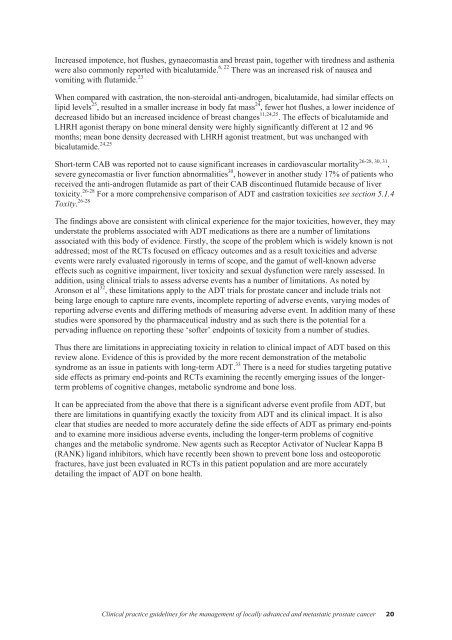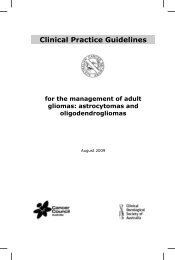Clinical Practice Guidelines for the management of locally advanced ...
Clinical Practice Guidelines for the management of locally advanced ...
Clinical Practice Guidelines for the management of locally advanced ...
Create successful ePaper yourself
Turn your PDF publications into a flip-book with our unique Google optimized e-Paper software.
Increased impotence, hot flushes, gynaecomastia and breast pain, toge<strong>the</strong>r with tiredness and as<strong>the</strong>nia<br />
were also commonly reported with bicalutamide. 6, 22 There was an increased risk <strong>of</strong> nausea and<br />
vomiting with flutamide. 23<br />
When compared with castration, <strong>the</strong> non-steroidal anti-androgen, bicalutamide, had similar effects on<br />
lipid levels 25 , resulted in a smaller increase in body fat mass 24 , fewer hot flushes, a lower incidence <strong>of</strong><br />
decreased libido but an increased incidence <strong>of</strong> breast changes 11,24,25 . The effects <strong>of</strong> bicalutamide and<br />
LHRH agonist <strong>the</strong>rapy on bone mineral density were highly significantly different at 12 and 96<br />
months; mean bone density decreased with LHRH agonist treatment, but was unchanged with<br />
bicalutamide. 24,25<br />
Short-term CAB was reported not to cause significant increases in cardiovascular mortality 26-28, 30, 31 ,<br />
severe gynecomastia or liver function abnormalities 30 , however in ano<strong>the</strong>r study 17% <strong>of</strong> patients who<br />
received <strong>the</strong> anti-androgen flutamide as part <strong>of</strong> <strong>the</strong>ir CAB discontinued flutamide because <strong>of</strong> liver<br />
toxicity. 26-28 For a more comprehensive comparison <strong>of</strong> ADT and castration toxicities see section 5.1.4<br />
Toxity. 26-28<br />
The findings above are consistent with clinical experience <strong>for</strong> <strong>the</strong> major toxicities, however, <strong>the</strong>y may<br />
understate <strong>the</strong> problems associated with ADT medications as <strong>the</strong>re are a number <strong>of</strong> limitations<br />
associated with this body <strong>of</strong> evidence. Firstly, <strong>the</strong> scope <strong>of</strong> <strong>the</strong> problem which is widely known is not<br />
addressed; most <strong>of</strong> <strong>the</strong> RCTs focused on efficacy outcomes and as a result toxicities and adverse<br />
events were rarely evaluated rigorously in terms <strong>of</strong> scope, and <strong>the</strong> gamut <strong>of</strong> well-known adverse<br />
effects such as cognitive impairment, liver toxicity and sexual dysfunction were rarely assessed. In<br />
addition, using clinical trials to assess adverse events has a number <strong>of</strong> limitations. As noted by<br />
Aronson et al 32 , <strong>the</strong>se limitations apply to <strong>the</strong> ADT trials <strong>for</strong> prostate cancer and include trials not<br />
being large enough to capture rare events, incomplete reporting <strong>of</strong> adverse events, varying modes <strong>of</strong><br />
reporting adverse events and differing methods <strong>of</strong> measuring adverse event. In addition many <strong>of</strong> <strong>the</strong>se<br />
studies were sponsored by <strong>the</strong> pharmaceutical industry and as such <strong>the</strong>re is <strong>the</strong> potential <strong>for</strong> a<br />
pervading influence on reporting <strong>the</strong>se ‘s<strong>of</strong>ter’ endpoints <strong>of</strong> toxicity from a number <strong>of</strong> studies.<br />
Thus <strong>the</strong>re are limitations in appreciating toxicity in relation to clinical impact <strong>of</strong> ADT based on this<br />
review alone. Evidence <strong>of</strong> this is provided by <strong>the</strong> more recent demonstration <strong>of</strong> <strong>the</strong> metabolic<br />
syndrome as an issue in patients with long-term ADT. 33 There is a need <strong>for</strong> studies targeting putative<br />
side effects as primary end-points and RCTs examining <strong>the</strong> recently emerging issues <strong>of</strong> <strong>the</strong> longerterm<br />
problems <strong>of</strong> cognitive changes, metabolic syndrome and bone loss.<br />
It can be appreciated from <strong>the</strong> above that <strong>the</strong>re is a significant adverse event pr<strong>of</strong>ile from ADT, but<br />
<strong>the</strong>re are limitations in quantifying exactly <strong>the</strong> toxicity from ADT and its clinical impact. It is also<br />
clear that studies are needed to more accurately define <strong>the</strong> side effects <strong>of</strong> ADT as primary end-points<br />
and to examine more insidious adverse events, including <strong>the</strong> longer-term problems <strong>of</strong> cognitive<br />
changes and <strong>the</strong> metabolic syndrome. New agents such as Receptor Activator <strong>of</strong> Nuclear Kappa B<br />
(RANK) ligand inhibitors, which have recently been shown to prevent bone loss and osteoporotic<br />
fractures, have just been evaluated in RCTs in this patient population and are more accurately<br />
detailing <strong>the</strong> impact <strong>of</strong> ADT on bone health.<br />
<strong>Clinical</strong> practice guidelines <strong>for</strong> <strong>the</strong> <strong>management</strong> <strong>of</strong> <strong>locally</strong> <strong>advanced</strong> and metastatic prostate cancer<br />
20



